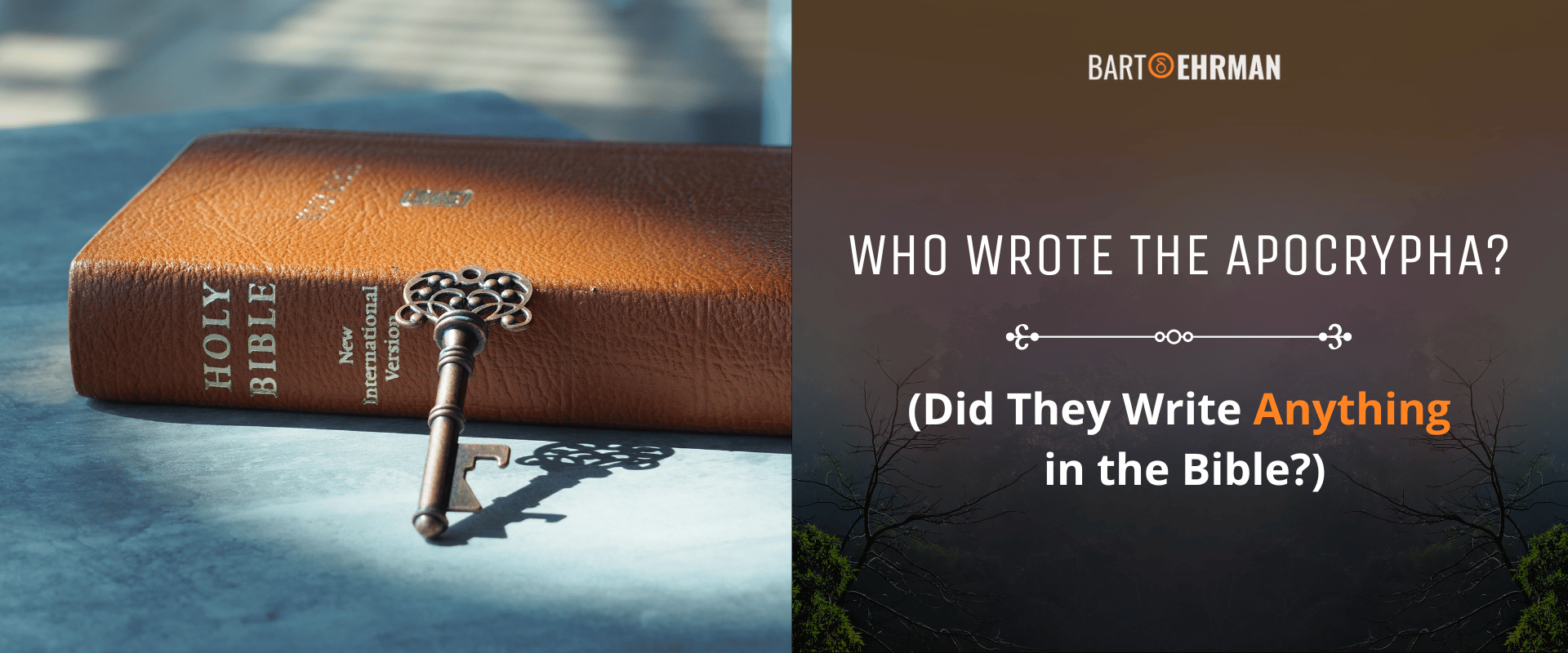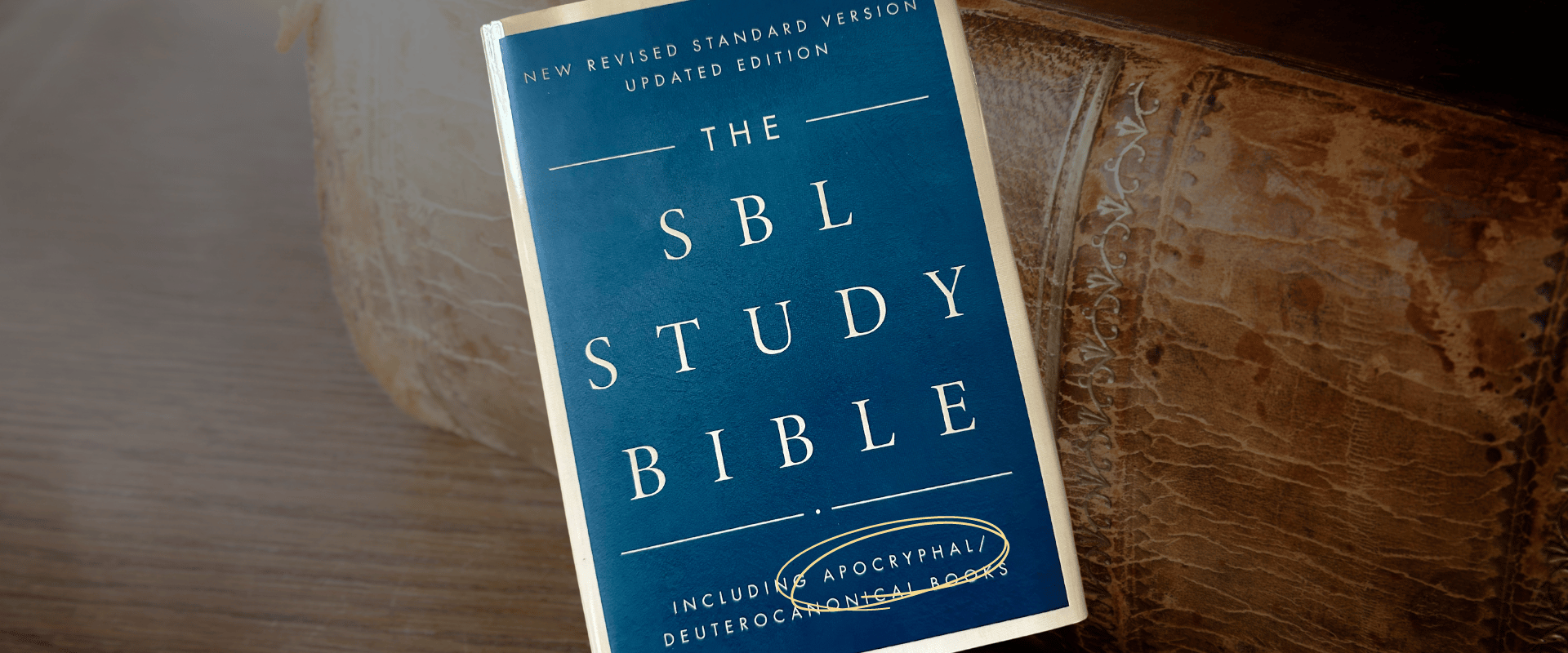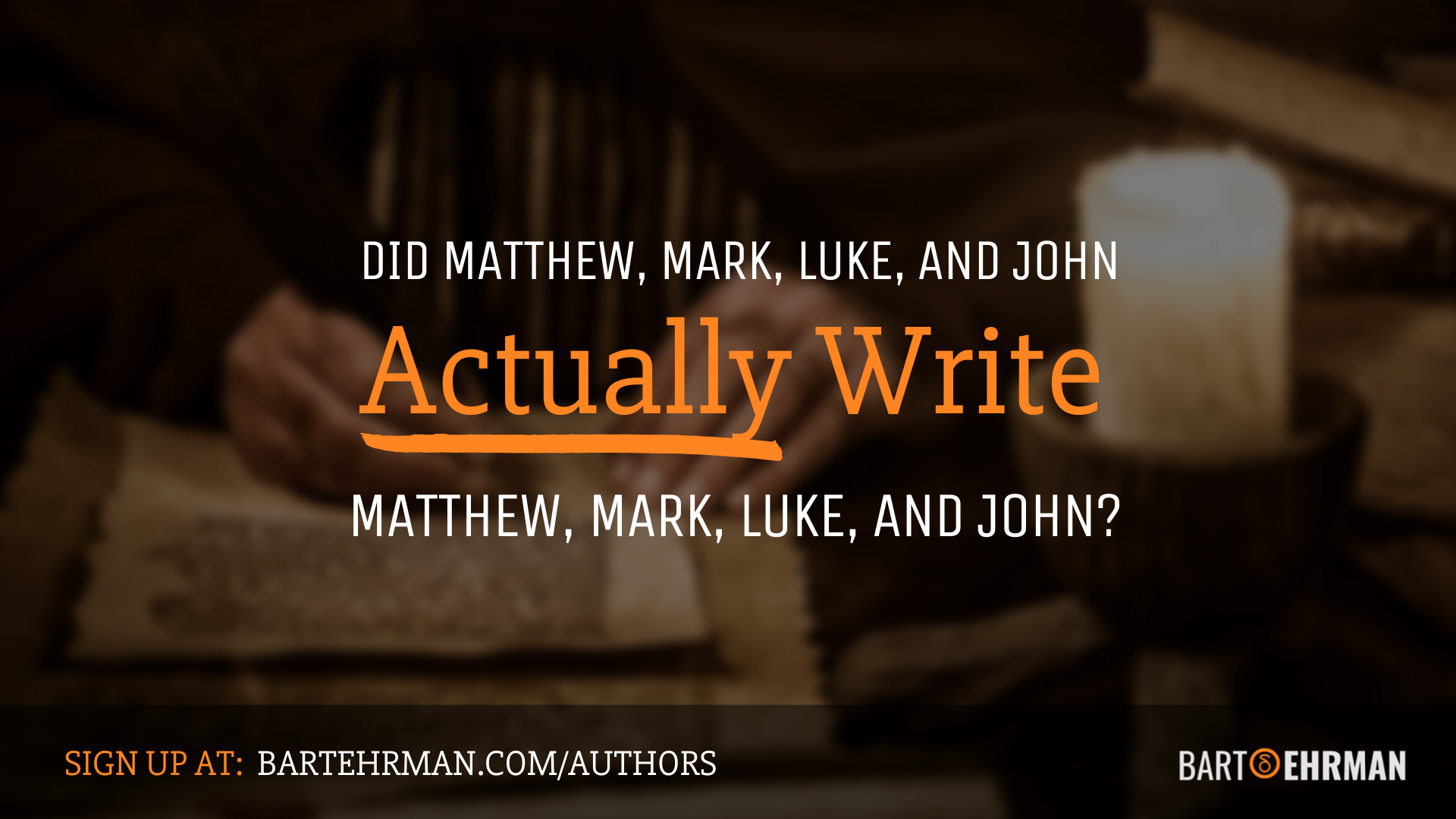Who Wrote the Apocrypha? (Did They Write Anything in the Bible?)

Written by Marko Marina, Ph.D.
Author | Historian
Author | Historian | BE Contributor
Verified! See our guidelines
Verified! See our editorial guidelines
Date written: August 18th, 2024
Edited by Laura Robinson, Ph.D.
Disclaimer: The views and opinions expressed in this article belong to the author and do not necessarily match my own. - Dr. Bart D. Ehrman
My students often find themselves more intrigued by the apocryphal books than by the ones that made it into the Bible. Perhaps it’s the mysterious term “Apocrypha” that hooks them. One student once joked, “It sounds like the title of a lost Indiana Jones movie!” This curiosity isn’t misplaced; the Apocrypha’s allure captures the imagination and prompts deeper questions about its origins and content.
But who wrote the Apocrypha? This question often surfaces early in our discussions. Understanding the authorship of these texts not only satisfies academic curiosity but also sheds light on the complex history of biblical literature.
In a previous article, we delved into when and why these books were removed from the Bible. That exploration laid the foundation for our current focus.
In this article, we’ll journey into the fascinating world of apocryphal authorship. We'll look at the origins of these texts, examine whether we know who wrote the Apocrypha books, and consider whether these authors contributed to the Bible’s canon.
By the end, you'll have a clearer picture of what we can know about this compelling topic!

What Are the Apocryphal Books?
The term “Apocrypha” originates from the Greek word for “hidden,” and it designates a collection of texts written by Jews during the Hellenistic and Roman periods (approximately 200 B.C.E. to 100 C.E.).
Some were included in the Septuagint (LXX), the Greek translation of the Hebrew Scriptures, which later became canonical for Catholic Christianity. These texts, included in the LXX and canonized by the Catholic Church, are the focus of this article.
As Otto Kaiser notes in his Introduction to the Apocrypha, these books provide a glimpse into how Judaism, within an increasingly Hellenized environment, articulated its faith in a divine election and the associated duty of obedience to the Torah, or the instruction of its God. (Affiliate Disclaimer: We may earn commissions on products you purchase through this page at no additional cost to you. Thank you for supporting our site!)
So, if you purchase a Bible today, you might find one that includes the Old Testament (OT), the New Testament (NT), and the Apocrypha. The Apocrypha includes books such as 1 and 2 Maccabees, Tobit, Judith, Wisdom of Solomon, Sirach (Ecclesiasticus), Baruch, and additions to Esther and Daniel. Unlike the rest of the Old Testament, these texts were written in Greek.
Protestant reformers in the 16th and 17th centuries created the Apocrypha category to distinguish these books from the Hebrew Bible. During this period, reformers such as Martin Luther and John Calvin argued that the Old Testament should only include books originally written in Hebrew.
However, the roots of this distinction trace back to antiquity. As it turns out, the first Christians didn’t have their own set of Scriptures and instead used the Jewish ones.
Since most came from a pagan background, they adopted the Septuagint, which was also used by Greek-speaking Jews.
But over time, Jewish authorities decided to canonize only those texts originally written in Hebrew, excluding Greek compositions like 1 and 2 Maccabees. Conversely, Christians continued to regard the Greek texts as part of their Old Testament.
To summarize, the Apocrypha comprises a set of ancient Jewish writings that bridge the Hebrew Bible and the New Testament. The ones that made their way into the Catholic canon include:
Understanding the origins and content of these books is crucial before delving into the question of who wrote the Apocrypha, as it sets the stage for exploring their historical and theological significance.
But to know more about Apocrypha content, I highly recommend an excellent article that my colleague Joshua wrote several months ago!
Who Are the Authors of the Apocrypha?
Historians establish the authorship of ancient texts by examining both internal evidence (clues from the text itself, such as style, vocabulary, and content) and external attestations (references by other authors and historical records that provide evidence about the text's origins).
It's a meticulous process that combines literary analysis with historical context. Of course, it can be incredibly frustrating when evidence is scant, leaving us historians to ponder the mysteries of authorship without definitive answers — much like a detective missing crucial clues in an ancient whodunit! So, join us as we delve into the “Who wrote the Apocrypha?” question!
Who Wrote 1 and 2 Maccabees?
The books of 1 and 2 Maccabees are Jewish historical works that chronicle the tumultuous period of the second century B.C.E., a time when the Jewish people faced significant challenges from both cultural and political forces. These texts provide detailed accounts of the Maccabean Revolt, a pivotal series of events in Jewish history.
The authorship of 1 Maccabees, like many ancient texts, remains a mystery. The text itself is anonymous, meaning we have no way of knowing the exact identity of the author. This anonymity is reminiscent of the New Testament Gospels, where the true authors also remain unknown, despite traditional attributions.
Nevertheless, scholars have gleaned certain cultural and personal details about the author through careful analysis of the text.
According to John R. Bartlett in his book The First and Second Books of the Maccabees:
"We do not know his name... He was an educated Jew, working probably in Jerusalem. He appears to be a little more interested in the political and military aspects than the religious... He was a man of judgment and ability who has made an important contribution to our knowledge of a complicated but interesting period of history.”
In other words, the author's background appears to be that of an educated Jewish historian, deeply familiar with both Jewish traditions and Hellenistic culture. His emphasis on political and military narratives over religious ones indicates a possible background in governance or military affairs.
Did You Know?
The Controversial History of the Apocrypha in Protestant Bibles
In 1615, Archbishop George Abbot, a prominent figure during the Reformation, forbade the issuance of Bibles without the Apocrypha. Despite this directive, editions of the King James Version from 1630 onwards frequently omitted these texts.
Interestingly, the Geneva Bible edition of 1640 was likely the first intentionally printed in England without the Apocrypha. This development highlights the significant tension and differing views among Protestant leaders regarding the inclusion of these books, which reflected the complex process of defining the biblical canon during the Reformation.
The authorship of 2 Maccabees, like its predecessor, is shrouded in mystery. However, unlike 1 Maccabees, 2 Maccabees is not a straightforward historical account, but a compilation of various documents, each serving a distinct purpose.
As Michael W. Duggan notes:
“Second Maccabees is comprised of three documents: (i) a letter from the Jewish community in Jerusalem and Judea to the Jews in Egypt (1:1–9); (ii) another letter from the people of Jerusalem and Judea along with the senate and Judas to the priest Aristobulus, and the Jews in Egypt (1:10–2:18); and (iii) an abridgment of a five-volume work by Jason of Cyrene (2:19–15:39; 2:23).”
The primary source of the historical narrative in 2 Maccabees is the work of Jason of Cyrene, whose five-volume history was abridged to create the account we have today. While Jason himself was responsible for the original detailed chronicles, the actual author of 2 Maccabees was the one who condensed and compiled these writings.
This individual was likely a Jewish historian with a strong literary background, well-versed in both Jewish traditions and Hellenistic literary practices.
The style and content suggest a deep commitment to preserving the historical and religious significance of the Maccabean Revolt, with an emphasis on the miraculous and moral lessons derived from these events.
It’s plausible that the person who compiled/edited these pieces into a single cohesive work resided in a major urban center outside of Palestine, perhaps in Alexandria, where a significant Jewish community thrived.
Who Wrote Tobit?
The Book of Tobit is a narrative that combines elements of folklore, religious piety, and didactic teaching. It tells the story of Tobit, a righteous Israelite of the tribe of Naphtali, who, despite his devoutness, suffers severe misfortunes, including blindness and financial ruin.
Through a series of divine interventions, guided by the archangel Raphael, Tobit's fortunes are restored, and his son Tobias marries Sarah, who is also delivered from a demonic curse.
In terms of theology, Otto Kaiser points out that this book emphasizes the belief in the righteousness of God, whose ways humans often cannot comprehend but who graciously guides the pious and ultimately delivers them from all dangers.
When it comes to the authorship of Tobit, the text is anonymous, much like 1 and 2 Maccabees. We have no direct information about who wrote it. The narrative's style and themes suggest it was composed by a Jewish author familiar with both Hebrew traditions and the broader Hellenistic culture of the time.
Who Wrote Judith?
The Book of Judith is a dramatic tale of salvation that revolves around a severe crisis and its ultimate resolution. The crisis unfolds on multiple levels: theologically, it presents a clash between the true God of Israel and the Assyrian king Nebuchadnezzar, who is depicted as a rival deity.
Politically and militarily, it narrates the struggle of the Israelites against the imperialist ambitions of the Assyrians, who seek to conquer and occupy their land. However, through the courageous actions of Judith, a devout widow, the Israelites are eventually delivered from their enemies.
The authorship of the Book of Judith, like many ancient texts, remains anonymous. There is no direct evidence to identify the author with certainty. However, scholars have made educated guesses based on internal and contextual clues. It’s widely believed that Judith may have been composed in either Hebrew or Greek by a Jewish author from Palestine.
As Deborah Levine Gera observes: “Judith may have been composed in either Hebrew or Greek, by a Jew who was familiar with both Greek culture and Hebrew scriptures. The importance allotted to Jerusalem and its temple points to a Palestinian author, as does the influence of Hasmonean events and issues.”
Who Wrote the Wisdom of Solomon?
The Wisdom of Solomon is a collection of eighteen psalms, transmitted primarily in Greek and Syriac, though they are believed to have originated in Hebrew. This collection includes various types of psalms: songs of praise, lament, and thanksgiving, reflecting the rich tradition of extracultic psalmody, which existed outside the formal liturgical practices of the Temple.
The authorship of this text, as you can anticipate, remains unknown. Scholars have dated the composition of these psalms to the first or second century B.C.E. — a period marked by significant political and social upheaval for the Jewish people.
Despite the lack of specific authorial attribution, it’s evident that the multiple authors deeply embedded in Jewish religious traditions wrote this book. Moreover, they were likely responding to the contemporary challenges faced by their community.
Who Wrote Sirach?
The Book of Sirach, also known as Ecclesiasticus, is a comprehensive collection of ethical teachings and maxims. It covers a wide range of topics, including morality, the law, worship, and the importance of wisdom.
Unlike many other apocryphal books, Sirach isn’t anonymous. The book is attributed to "Jesus, son of Eleazar, son of Sira of Jerusalem" (Sir 50.27).
As Michael D. Coogan explains in The Old Testament: A Historical and Literary Introduction, the author's name “Jesus” is a Greek rendering of the Hebrew "Yeshua," a common name among Jews of the Hellenistic and Roman periods. To distinguish him from Jesus of Nazareth, the author is generally referred to as Ben Sira or Sirach, the latter being a Greek form of his name.
Ben Sira was a learned Jewish scribe and teacher in Jerusalem who composed his writing at the end of the 2nd century B.C.E.
Jeremy Corley notes that the year 175 B.C.E. is likely the latest possible date for the book because Ben Sira makes no direct mention of the religious disturbances (1 Macc 1:10–64) ensuing from the accession of the Seleucid king Antiochus IV Epiphanes (175–164 B.C.E.), the persecutor of the Jews.
Who Wrote Baruch?
The Book of Baruch is a brief but poignant work that combines elements of prophecy, prayer, and reflection. It presents itself as a compilation of speeches and prayers attributed to Baruch, the companion and scribe of the prophet Jeremiah (c. 650-570 B.C.E.).
The text focuses on themes of repentance, wisdom, and hope for deliverance, addressing the Jewish community in the context of exile and suffering.
It must be noted that the modern scholarship has seriously challenged the traditional attribution. Otto Kaiser notes that the “pseudepigraphical and ahistorical character of the introduction and tradition-historical evidence speak against dating the book before the second century.”
Similarly, Karina M. Hogan asserts that current scholarship generally dates the composition of Baruch to the second century B.C.E. This dating is based on thematic and stylistic parallels with other texts from the same period, such as the Book of Daniel, the writings of Ben Sira, and the Apocryphon of Jeremiah from the Qumran scrolls.
The anonymous author was likely a Jewish scholar deeply influenced by the religious and cultural milieu of the second century B.C.E., seeking to address the spiritual and communal needs of the Jewish people during a time of Hellenistic influence and internal struggle.
Having dealt with the question of who wrote the Apocrypha by looking at the most important books within this category, we now turn to the peculiar additions that were inserted into two canonical books: Esther and Daniel!

Who Wrote the Additions to the Book of Esther?
The Book of Esther is a captivating narrative found in the Hebrew Bible. It recounts the story of a Jewish woman named Esther who becomes queen of Persia and, through her bravery and cunning, saves her people from a planned genocide.
While the Book of Esther itself isn’t considered apocryphal, several Greek additions to the text are classified as part of the Apocrypha. These additions include prayers, dream sequences, and clarifications that expand on the original Hebrew version.
The Greek additions to Esther were likely composed during the Hellenistic period and inserted into the text to address certain perceived gaps and enhance its religious and theological dimensions.
As far as the authorship of these additions is concerned, it remains anonymous. Otto Kaiser notes how a closer examination of the text shows that the additions go back to two different traditions, of which the older, Egyptian tradition ( c. 130-110 B.C.E.) emphasized the loyalty between the foreign king and the Jews, while the younger, Palestinian tradition ( c. 103-76 B.C.E.) sought a transparent theologizing.
Furthermore, Karen H. Jobes and Moisés Silva, in their book Invitation to the Septuagint, explain that these additions were likely composed by Jewish translators who aimed to make the Hebrew scriptures more accessible and relevant to Greek-speaking Jews, enhancing the story’s religious and theological aspects.
However, they maintain a more skeptical tone than Otto Kaiser, emphasizing that these additions reflect the concerns of the person(s) who introduced them, but because they can’t be accurately dated, it’s difficult to infer from them what specific historical moment motivated their inclusion.
Who Wrote the Additions to the Book of Daniel?
The final piece of the Apocryphal puzzle that brings us close to the end of our exploration into the “Who wrote the Apocrypha” question is related to the Book of Daniel. Daniel is a fascinating work within the Hebrew Bible known for its mixture of apocalyptic visions and court tales to convey themes of divine sovereignty and faithful endurance.
According to most scholars, it’s a pseudepigraphical work. The book is believed to have been written by an anonymous writer in the middle of the 2nd century B.C.E. It was a time of intense persecution of the Jewish people under the Seleucid ruler Antiochus IV Epiphanes.
The Additions to the Book of Daniel are a captivating set of texts that include the “Prayer of Azariah” and the “Song of the Three Holy Children,” “Susanna,” and “Bel and the Dragon”. These additions are found in the Greek versions of Daniel (e.g. Septuagint) but not in the Hebrew Masoretic Text.
As for the authorship of these additions, it remains anonymous, similar to many other apocryphal works. Scholars believe these texts were likely composed during the Hellenistic period, possibly around the same time as or slightly after the composition of the main body of Daniel.
Lorenzo DiTommaso provides insight into this matter, noting:
“The current state of the evidence does not permit a firm judgment whether one or more of the Greek Additions, either in their present forms or proto-versions, was in circulation before the final redaction of MT Daniel in 164 B.C.E... The original forms of the additions, in whatever state they may have been, were probably composed in Aramaic or Hebrew, although the degree of certainty varies in each case.”
These additions were likely created by Jewish scholars who sought to expand the narrative of Daniel, providing additional moral and theological reflections.
The exact timing and circumstances of their composition remain uncertain, but their integration into the Greek translations underscores their importance in the religious and cultural landscape of Hellenistic Judaism.
Did the Apocryphal Authors Write Anything Else in the Bible?
When examining the authorship of the Apocrypha, one might wonder whether any of the authors of these texts also contributed to the canonical books of the Bible. However, given the nature of these texts and the historical context, the answer is largely speculative.
As we saw, most apocryphal books are, strictly speaking, anonymous. We have no way of knowing the authors’ exact identities. All we can do is speculate about their cultural backgrounds based on the traces of internal evidence.
In some cases, as with the Book of Sirach (Ecclesiasticus), the author is known — Jesus, son of Eleazar, son of Sira — but there is no evidence to suggest that Ben Sira wrote any canonical biblical texts.
The Greek Additions to Esther and Daniel are expansions of existing biblical texts rather than original works by new authors. Jewish scholars likely made them during the Hellenistic period, but their specific identities remain unknown.
So, while the Apocryphal books are integral to understanding the broader context of Jewish literature and thought, there is no definitive evidence that any of their authors also contributed to the canonical books of the Bible.
Conclusion
While learning who wrote the Apocrypha, we have delved into the authorship and historical context of several significant apocryphal books. These texts, written during the Hellenistic and Roman periods, provide valuable insights into Jewish religious thought and cultural interactions.
While some, like Ben Sira, are known by name, most authors of Apocrypha remain anonymous, and their works reflect the complex relationship between Jewish literature and the broader Hellenistic world.
Ultimately, while we can infer much about the cultural and historical contexts in which these texts were written, the question of overlapping authorship with canonical books remains largely speculative.
For those interested in further exploring the fascinating interplay between history, myth, and tradition in biblical texts, I highly recommend the online course “In the Beginning: History, Myth, and Tradition in Genesis” by Dr. Bart D. Ehrman.
In this course, Dr. Ehrman provides a fresh and scholarly look at some of the most famous stories from the Book of Genesis, delineating between real history and myth. This course is an excellent opportunity to deepen your understanding of biblical narratives and their historical contexts.
FREE COURSE!
WHY I AM NOT A CHRISTIAN
Raw, honest, and enlightening. Bart's story of why he deconverted from the Christian faith.
Over 6,000 enrolled!

